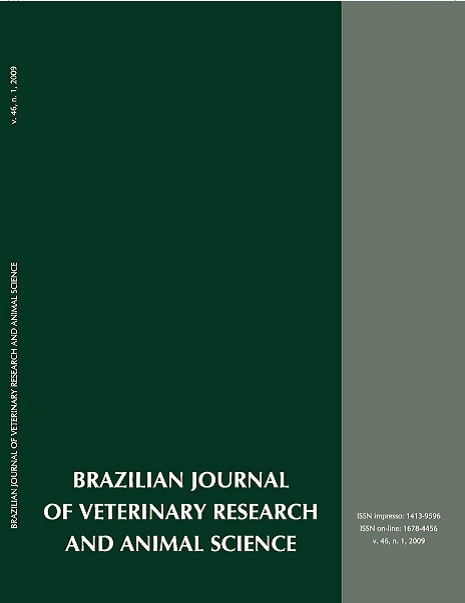Ammonia poisoning in cattle fed extruded or prilled urea: alterations in some chemistry components
DOI:
https://doi.org/10.11606/issn.1678-4456.bjvras.2009.26752Keywords:
Urea, Ammonia, Bovines, Poisoning, Biochemical changesAbstract
Twelve yearling Girolando steers never fed urea before were assigned randomly in two groups of six animals each. In both groups were administered intraruminally a single dose (0.5 g/kg BW) of extruded or prilled urea in order to induce ammonia poisoning. Plasma or serum levels of ammonia, urea, creatinine, glucose, L-lactate were determined. Hematocrit values were also recorded. Blood samples were taken before the administration of urea, at the onset of muscle tremors, at the first convulsive episode, and 240 minutes after the beginning of the urea feeding. Hyperammonemia already occured at the time of the first muscle tremors. Glucose and L-lactate levels were higher at the peak of the intoxication (convulsive episode), which were higher compared to the beginning of the experiment. Endogenous production of urea increased during the experiment due to hyperammonemia (r = 0.57), reaching peak levels at the end of the trials. Higher ammonia values lead to increased concentrations of L-lactate, glucose, urea, creatinine and hematocrit values. These results showed that high levels of ammonia increased glyconeogenesis, anaerobic glycolysis, the endogenous synthesis of urea and the level of dehydration. L-lactate and glucose were the best variables to monitor biochemical changes in cases of ammonia poisoning.Downloads
Download data is not yet available.
Downloads
Published
2009-02-01
Issue
Section
UNDEFINIED
License
The journal content is authorized under the Creative Commons BY-NC-SA license (summary of the license: https://
How to Cite
1.
Antonelli AC, Torres GAS, Mori CS, Soares PC, Maruta CA, Ortolani EL. Ammonia poisoning in cattle fed extruded or prilled urea: alterations in some chemistry components. Braz. J. Vet. Res. Anim. Sci. [Internet]. 2009 Feb. 1 [cited 2024 Apr. 18];46(1):69-76. Available from: https://www.revistas.usp.br/bjvras/article/view/26752





